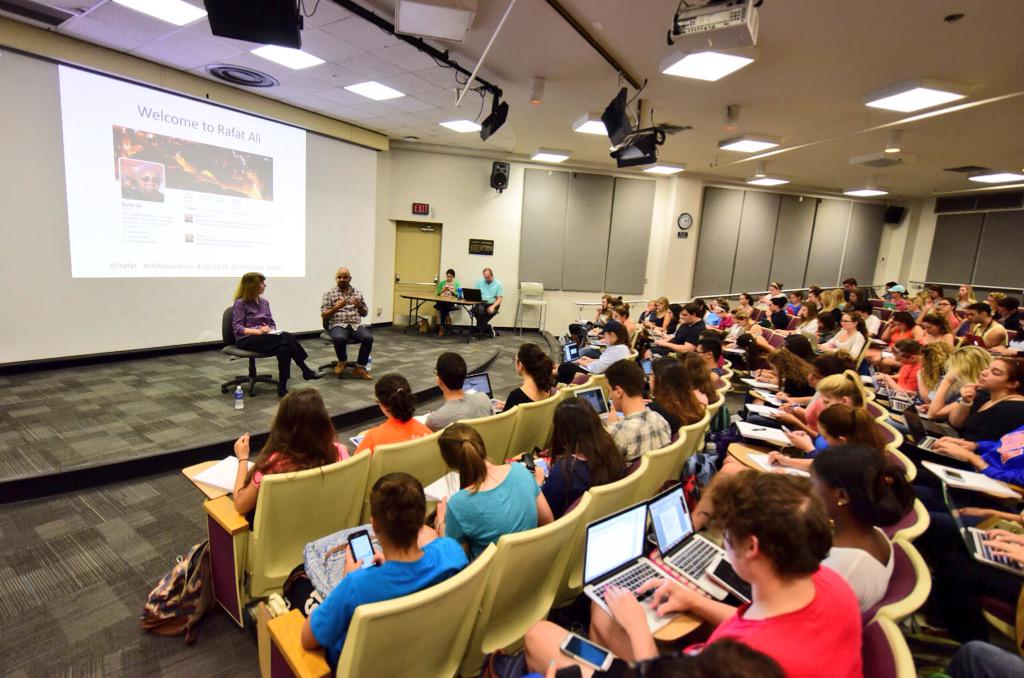
An increase in microphone use by instructors is one of the results of the pandemic and the increase in online and hybrid teaching.
Prior to the pandemic, most instructors taught in classrooms that didn’t require microphone use. Many instructors had never used microphones in their classrooms and, perhaps, had only used a microphone for making a conference presentations.
Even auditorium teaching doesn’t always require a microphone, depending on the design of the auditorium and the instructor’s voice projection.
With the pandemic, most instructors moved to teaching with microphones. Teaching via Zoom, using their laptops. Teaching in an in-person setting and wearing a mask. Teaching in a hybrid environment, with some students in the classroom and others participating online. Recording classes – or entire courses – for asynchronous learning.

I asked University of South Carolina faculty member and former sportscaster Dr. Kevin Hull to join me to discuss microphone use for instructors.
Hull is associate professor of journalism and Sport Media Lead in the School of Journalism and Mass Communication. He was named a “Breakthrough Star” by the University of South Carolina and named “Promising Professor” by the Association for Education in Journalism and Communication’s Mass Communication and Society Division.
Julie Dodd: Let’s talk about the microphones instructors might use for in-person teaching, online teaching or conference presentations.

Kevin Hull: When teaching, the lavalier is probably the best option because it allows you to essentially teach how you normally would – except you’re now wearing a microphone. You don’t have to worry about holding anything, and you can move around the room freely.
Clip the microphone to an area right around the top of your chest and then put the receiver in your pocket or clip it to your belt. Make sure it is turned on and you’re good to go.
Julie Dodd: When I first used lavalier microphones, I realized the placement of the microphone and the receiver involved some wardrobe planning. The neckline and fabric of a blouse may not work well for microphone placement. I also needed to wear slacks or a skirt with a waistband or pocket or wear a jacket with a pocket for the transmitter.
Some lavalier microphones use Bluetooth but some have small cables connecting the microphone and the receiver. In using a lavalier with a cable, you have to decide whether to let the cable show or whether to place the cable under your jacket or blouse. Also, the movement of longer hair or jewelry can be picked up by the lavalier microphone. Even though you, as the speaker, might not notice those sounds, your audience will.
Some classrooms and conference settings have handheld microphones. What’s the best approach to using those microphones?
Kevin Hull: The handheld microphone should be held a few inches below your mouth. It does not have to be directly next to your lips or be held so it looks like you are eating it. The handheld should pick up the sound of basically everything in front of it, meaning that it will get your audio, but not much else in the room. Much like lavalier, there should be an on switch somewhere on it, so just click that and you should be ready to start.
Julie Dodd: When I’ve made presentations at the University of Florida’s orientation for new teaching assistants, I had the choice of using a lavalier or handheld microphone and chose the handheld mic. I could pose a question and then move into the auditorium of 400 TAs to ask individuals to share their responses with the group. That way their comments were heard by all, and I didn’t need to restate what they said.

Another microphone option in some auditoriums and in some conference setups is the lectern microphone.
Kevin Hull: The lectern microphone is the most limiting because you are stuck behind that podium the entire time. One of the main issues I see with that microphone is that people think they need to be directly next to it. When they are speaking, they are either hunched over if they are taller or on their toes if they are shorter. In most cases, you shouldn’t have to do anything to your height once you adjust microphone slightly up or down. Just be sure to stay behind the microphone and start talking.
Julie Dodd: We’ve all seen those situations when someone using a lectern microphone is somewhat thrown off in their speaking by just what you said – adjusting themselves rather than the microphone. Be sure to take the time to adjust the microphone before you start speaking. Remember that the person who used the microphone before you may have been much taller or shorter. And those who are shorter may want to request (or own) a step-up box to use when speaking at a lectern with built-in microphone. Not only does the step-up box create better audio but will create better eye contact for the instructor and the audience.
As you said, the lectern microphone is limiting – not only because you need to stay behind the lectern but because you must face the microphone when speaking. I’ve seen for some instructors or presenters using a lectern microphone turn away from the microphone to speak as they look at the screen and their presentation slide. Because they aren’t facing the microphone, the audience can’t hear their remarks.
In your work as a broadcast journalist, you spent much of your job using microphones, both live and recorded. What advice do you have about voice quality and microphone use?

Kevin Hull: The key with any of these microphones is that they will emphasize your normal speaking voice. Therefore, you do not have to yell or speak any louder while using it. Simply speak at your normal voice and let the amplifying technology do the rest.
Another key to remember is that these microphones are always on. Sneezes, coughs, comments under your breath, or anything that you normally wouldn’t want broadcast loudly will be broadcast VERY loudly. When class is over, turn off the microphone immediately or else the private conversation that a student wants to have with you will be broadcast to the entire room.
Julie Dodd: Good advice. When I ask students to participate in a partner or small group activity during class, I move around the auditorium to hear what students are sharing – and to make sure everyone is on task. If I make any comments to a group or a student, that comment is broadcast to the whole auditorium. So, I have to remember to turn off the mic when I move around the auditorium during the activity.
Another microphone tip. If you teach in classroom that requires a microphone, be sure have extra batteries for the microphone. Sometimes auditoriums with microphones will have extra batteries on the lectern or computer console – but not always. At UF, you can call the technology office, and a tech assistant will bring batteries to your classroom. But that may take 10-15 minutes, which is a chunk of time in a 50-minute class. Best to have your own batteries with you – and remember that mics require different batteries, not one-size-fits-all.
Many instructors never used microphones in their teaching until the pandemic required online teaching. What advice do you have about how teachers can improve the audio quality of their online teaching — whether teaching via video-conferencing or creating recorded presentations?
Kevin Hull: Microphones make a big difference when recording audio through your computer. Some can be a little pricey, but they also pick up the audio clearly and won’t force you to sit just a few inches in front of the computer. When I’m recording interviews through Zoom, I use a Blue Yeti microphone. This connects directly to the USB port of my computer and Zoom automatically recognizes it as the microphone to use.
When I’m recording lectures into my camera, I use a lavalier microphone that I can clip directly to my shirt. I bought a lavalier microphone for under $25, which isn’t the high end but gets the job done.
An often-forgotten part of audio recording is that a microphone will record everything that is happening in the room. If your phone dings from a text message alert, the air conditioning is humming right above your head, or the television is on in the background, be prepared to have those sounds be a part of your recorded lecture. Therefore, pick a quiet time and place to record everything. If you know that the dog barks when garbage is collected on Thursday mornings, as mine does, then you know not to start a new recording during that time.
Julie Dodd: Be sure to do a sound check before you start class. Turn on the mic and ask those in the back of the auditorium or classroom if they can hear you and adjust the volume accordingly.
Thanks to Kevin Hull for sharing advice on microphone use. You can follow Kevin on Twitter — @drkevhull
